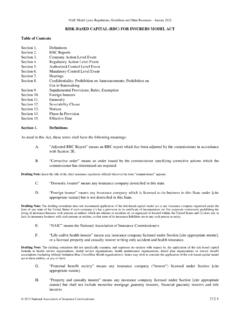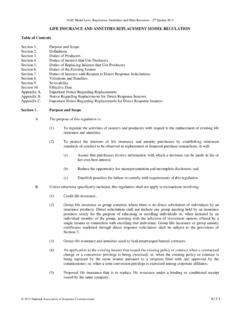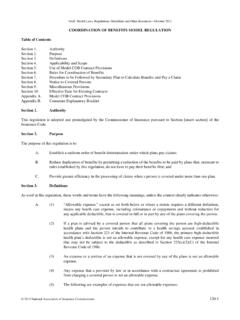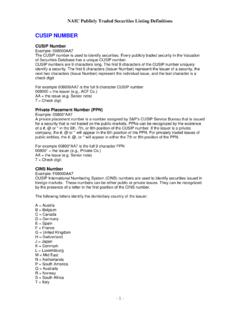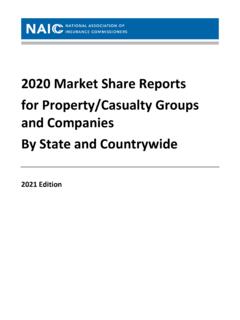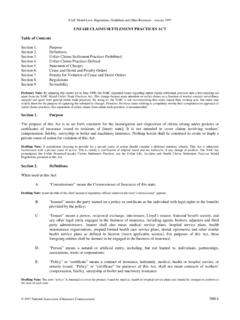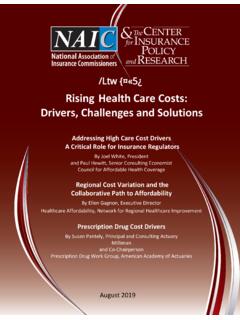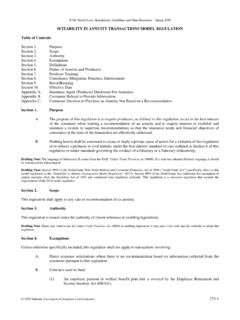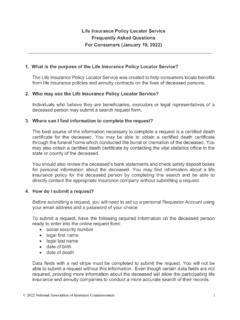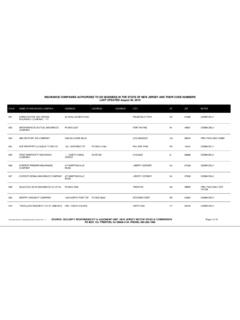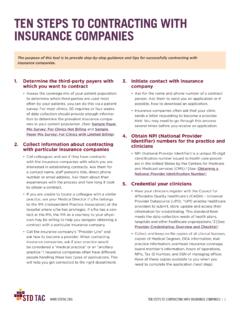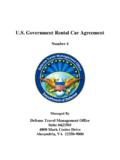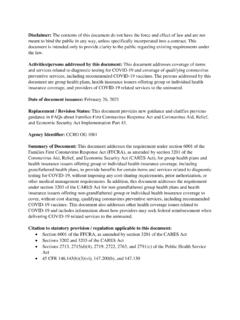Transcription of INSURANCE HOLDING COMPANY SYSTEM REGULATORY …
1 NAIC Model Laws, Regulations, Guidelines and Other Resources 1st Quarter 2015 2015 National Association of INSURANCE Commissioners 440-1 INSURANCE HOLDING COMPANY SYSTEM REGULATORY ACT Table of Contents Section 1. Definitions Section 2. Subsidiaries of Insurers Section 3. Acquisitions of Control of or Merger With Domestic Insurer Section Acquisitions Involving Insurers Not Otherwise Covered Section 4. Registration of Insurers Section 5. Standards and Management of an Insurer Within an INSURANCE HOLDING COMPANY SYSTEM Section 6. Examination Section 7. Supervisory Colleges Section Group-wide Supervision of Internationally Active INSURANCE Groups Section 8. Confidential Treatment Section 9. Rules and Regulations Section 10. Injunctions, Prohibitions against Voting Securities, Sequestration of Voting Securities Section 11. Sanctions Section 12. Receivership Section 13. Recovery Section 14. Revocation, Suspension, or Nonrenewal of Insurer s License Section 15. Judicial Review, Mandamus Section 16.
2 Conflict with Other Laws Section 17. Separability of Provisions Section 18. Effective Date Appendix. Alternate Provisions Section 1. Definitions As used in this Act, the following terms shall have these meanings unless the context shall otherwise require: A. Affiliate. An affiliate of, or person affiliated with, a specific person, is a person that directly, or indirectly through one or more intermediaries, controls, or is controlled by, or is under common control with, the person specified. B. Commissioner. The term commissioner shall mean the INSURANCE commissioner, the commissioner s deputies, or the INSURANCE Department, as appropriate. Drafting Note: Insert the title of the chief INSURANCE REGULATORY official wherever the word commissioner appears. C. Control. The term control (including the terms controlling, controlled by and under common control with ) means the possession, direct or indirect, of the power to direct or cause the direction of the management and policies of a person, whether through the ownership of voting securities, by contract other than a commercial contract for goods or nonmanagement services, or otherwise, unless the power is the result of an official position with or corporate office held by the person.
3 Control shall be presumed to exist if any person, directly or indirectly, owns, controls, holds with the power to vote, or holds proxies representing, ten percent (10%) or more of the voting securities of any other person. This presumption may be rebutted by a showing made in the manner provided by Section 4K that control does not exist in fact. The commissioner may determine, after furnishing all persons in interest notice and opportunity to be heard and making specific findings of fact to support the determination, that control exists in fact, notwithstanding the absence of a presumption to that effect. D. Group-wide supervisor. The REGULATORY official authorized to engage in conducting and coordinating group-wide supervision activities who is determined or acknowledged by the commissioner under Section to have sufficient significant contacts with the internationally active INSURANCE group.
4 E. INSURANCE HOLDING COMPANY SYSTEM . An INSURANCE HOLDING COMPANY SYSTEM consists of two (2) or more affiliated persons, one or more of which is an insurer. INSURANCE HOLDING COMPANY SYSTEM REGULATORY Act 440-2 2015 National Association of INSURANCE Commissioners F. Insurer. The term insurer shall have the same meaning as set forth in Section [insert applicable section] of this Chapter, except that it shall not include agencies, authorities or instrumentalities of the United States, its possessions and territories, the Commonwealth of Puerto Rico, the District of Columbia, or a state or political subdivision of a state. Drafting Note: References in this model act to Chapter are references to the entire state INSURANCE code. Drafting Note: States should consider applicability of this model act to fraternal societies and captives. G. Internationally active INSURANCE group. An INSURANCE HOLDING COMPANY SYSTEM that (1) includes an insurer registered under Section 4; and (2) meets the following criteria: (a) premiums written in at least three countries, (b) the percentage of gross premiums written outside the United States is at least ten percent (10%) of the INSURANCE HOLDING COMPANY SYSTEM s total gross written premiums, and (c) based on a three-year rolling average, the total assets of the INSURANCE HOLDING COMPANY SYSTEM are at least fifty billion dollars ($50,000,000,000) or the total gross written premiums of the INSURANCE HOLDING COMPANY SYSTEM are at least ten billion dollars ($10,000,000,000).
5 H. Enterprise Risk. Enterprise risk shall mean any activity, circumstance, event or series of events involving one or more affiliates of an insurer that, if not remedied promptly, is likely to have a material adverse effect upon the financial condition or liquidity of the insurer or its INSURANCE HOLDING COMPANY SYSTEM as a whole, including, but not limited to, anything that would cause the insurer s Risk-Based Capital to fall into COMPANY action level as set forth in [insert cross reference to appropriate section of Risk-Based Capital (RBC) Model Act] or would cause the insurer to be in hazardous financial condition [insert cross reference to appropriate section of Model Regulation to define standards and commissioner s authority over companies deemed to be in hazardous financial condition]. I. Person. A person is an individual, a corporation, a limited liability COMPANY , a partnership, an association, a joint stock COMPANY , a trust, an unincorporated organization, any similar entity or any combination of the foregoing acting in concert, but shall not include any joint venture partnership exclusively engaged in owning, managing, leasing or developing real or tangible personal property.
6 J. Securityholder. A securityholder of a specified person is one who owns any security of such person, including common stock, preferred stock, debt obligations and any other security convertible into or evidencing the right to acquire any of the foregoing. K. Subsidiary. A subsidiary of a specified person is an affiliate controlled by such person directly or indirectly through one or more intermediaries. L. Voting Security. The term voting security shall include any security convertible into or evidencing a right to acquire a voting security. Section 2. Subsidiaries of Insurers A. Authorization. A domestic insurer, either by itself or in cooperation with one or more persons, may organize or acquire one or more subsidiaries. The subsidiaries may conduct any kind of business or businesses and their authority to do so shall not be limited by reason of the fact that they are subsidiaries of a domestic insurer.
7 Drafting Note: This bill neither expressly authorizes noninsurance subsidiaries nor restricts subsidiaries to INSURANCE related activities. It is believed that this is a policy decision which should be made by each individual state. Attached as an appendix are alternative provisions which would authorize the formation or acquisition of subsidiaries to engage in diversified business activity. B. Additional Investment Authority. In addition to investments in common stock, preferred stock, debt obligations and other securities permitted under all other sections of this Chapter, a domestic insurer may also: NAIC Model Laws, Regulations, Guidelines and Other Resources 1st Quarter 2015 2015 National Association of INSURANCE Commissioners 440-3 (1) Invest, in common stock, preferred stock, debt obligations, and other securities of one or more subsidiaries, amounts which do not exceed the lesser of ten percent (10%) of the insurer s assets or fifty percent (50%) of the insurer s surplus as regards policyholders, provided that after such investments, the insurer s surplus as regards policyholders will be reasonable in relation to the insurer s outstanding liabilities and adequate to meet its financial needs.
8 In calculating the amount of such investments, investments in domestic or foreign INSURANCE subsidiaries and health maintenance organizations shall be excluded, and there shall be included: (a) Total net monies or other consideration expended and obligations assumed in the acquisition or formation of a subsidiary, including all organizational expenses and contributions to capital and surplus of the subsidiary whether or not represented by the purchase of capital stock or issuance of other securities, and (b) All amounts expended in acquiring additional common stock, preferred stock, debt obligations, and other securities; and all contributions to the capital or surplus of a subsidiary subsequent to its acquisition or formation; Drafting Note: When considering whether to amend its HOLDING COMPANY Act to exempt health maintenance organizations and other similar entities from certain investment limitations, a state should consider whether the solvency and general operations of the entities are regulated by the INSURANCE department.
9 In addition to, or in place of, the term health maintenance organizations in Paragraph (1) above, a state may include any other entity which provides or arranges for the financing or provision of health care services or coverage over which the commissioner possesses financial solvency and REGULATORY oversight authority. (2) Invest any amount in common stock, preferred stock, debt obligations and other securities of one or more subsidiaries engaged or organized to engage exclusively in the ownership and management of assets authorized as investments for the insurer provided that each subsidiary agrees to limit its investments in any asset so that such investments will not cause the amount of the total investment of the insurer to exceed any of the investment limitations specified in Paragraph (1) or in Sections [insert applicable section] through [insert applicable section] of this Chapter applicable to the insurer.
10 For the purpose of this paragraph, the total investment of the insurer shall include: (a) Any direct investment by the insurer in an asset, and (b) The insurer s proportionate share of any investment in an asset by any subsidiary of the insurer, which shall be calculated by multiplying the amount of the subsidiary s investment by the percentage of the ownership of the subsidiary; (3) With the approval of the commissioner, invest any greater amount in common stock, preferred stock, debt obligations, or other securities of one or more subsidiaries; provided that after the investment the insurer s surplus as regards policyholders will be reasonable in relation to the insurer s outstanding liabilities and adequate to its financial needs. C. Exemption from Investment Restrictions. Investments in common stock, preferred stock, debt obligations or other securities of subsidiaries made pursuant to Subsection B shall not be subject to any of the otherwise applicable restrictions or prohibitions contained in this Chapter applicable to such investments of insurers [except the following: ].

